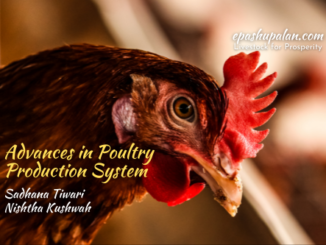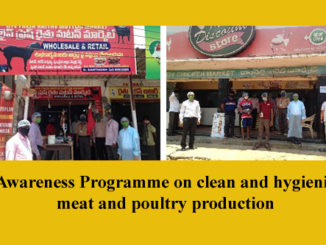Introduction
India has the largest livestock population throughout the country. Meat sector plays an important role in India as it not only provides meat and by-products for human consumption but also contributes towards sustainable livestock development and livelihood security for millions of men and women from weaker sections. Vegetarians choose not to eat meat because of ethical, economic, environmental, and religious or health concerns that are associated with meat production and consumption. Though there are many constraints for the slow growth of the Indian meat industry which include factors such as lack of scientific approach to rearing of meat animals, unorganized nature of meat production, socio-economic taboo and inadequate infrastructure facilities. India exports both frozen and fresh chilled meat.
Industrial Farming
Every 10 seconds humans kill roughly 24,000 animals for food that adds up to 75 billion each year and present era. It is done with a speed and efficiency previously unimaginable. Land, water greenhouse gas emissions involved in meat production are rapidly becoming unsustainable. We eat animals, we eat their eggs, we drink their milk, we fish – all on an arguably gripping scale. For most of us it’s an unexamined habit that’s not carried out with any intended malice, but that doesn’t mean there are no consequences., Our present food system is extremely inefficient as we feed grains/fodder to cows, goats, and chickens and then eat the animals. So, in essence, for every 9 calories of food fed to a chicken, we get 1 calorie back.
82% of starving children live in countries where food is fed to animals, and the animals are eaten by more well off individuals in developed countries like the US, UK, and in Europe. One fourth of all grain produced by third world countries is now given to livestock, in their own country and out. Infact meat demand isn’t going away, but it’s expected to reach 455 million tons by 2050, so the present question is how the future generations satisfy their craving for meat!
Increasing public awareness of food borne illnesses, factory farming, and the ecological footprint of the meat industry, has generated the need for animal-free meat alternatives. One of the most promising technologies to help face this challenge is cell-based meat. Several meat substitutes have been developed across the last decades and meat alternatives entirely made of vegetable components have gained market share.
Impossible Foods and Beyond Meat are the biggest companies in this sector. These plant based Vegan alternatives are products that tastes and looks like meat. Beyond Meat’s which was found in 2009 has created ‘Beyond Burger’- ‘the world’s first plant-based burger that looks, cooks, and satisfies like beef’. The ‘Impossible Burger’ from the Impossible Foods. A burger made from plants that ‘delivers all the flavor, aroma and beefiness of meat from cows’. Normally Meat have distinct flavor due to heme – an iron containing molecule. American company Impossible Foods patented a way to synthesize lab heme.
Impossible Foods is already available retail stores, multiple restaurant chains in various parts of United States, Hong Kong, Macau, and Singapore. And Beyond Meat is available in 50 countries including Australia, the UK, Canada, Chile, Germany, Israel, Korea, Mexico, South Africa, Taiwan, and the United Arab Emirates. Although different cell based meat startups have entered the market they are constantly tweaking their product to make it 100% taste like meat. The Indian company Good Dot in Mumbai makes everything from burgers to Kheema Pav from plant-based meat substitute.
Cultured Meat
- And here comes another alternative to raising cattle and poultry for meat – Cultured Meat.
- The world’s first cell-based meat company, “Memphis Meats” has found
- investment support from visionaries such as Bill Gates and Richard Branson.
- Cell-based meat (often referred to as clean meat or cultured meat) is genuine animal meat that can replicate the sensory and nutritional profile of conventionally produced meat because it’s comprised of the same cell types and arranged in the same three-dimensional structure as animal tissue. It isn’t imitation or synthetic meat; it’s actual meat that is grown from cells outside of an animal. Cultured
- meat, is a fairly new concept that refers to meat grown in a lab from a small sample of cells taken from an animal.
- The procedure requires the extraction of stem cells (Fetal bovine serum) from an unborn cow or immediately after killing it which then proliferate by using growth medium to produce animal tissue structures.
- Globally, the Netherlands, the U.S., Israel, Japan, and Singapore are developing both plant-based and clean meat.
How it Helps /Assists
- By growing meat from cells instead of from a whole animal, it becomes possible to create high-quality cuts of meat using fewer resources and with less environmental impact. Besides the incredible fact that it is possible to make animal meat and milk without requiring an animal, cellular agriculture is very important to the development of a sustainable system for livestock agricultural
- Compared to conventional beef, cell- based beef is estimated to reduce land use by more than 95%, climate change emissions by 74% to 87%, and nutrient pollution by 94%. Since cell- based meat is grown in a clean facility, it also reduces the risk of contamination by harmful pathogens and eliminates the need for antibiotics, thereby reducing the serious public health threats posed by food borne illness and antibiotic resistance bacteria/viruses.
- Beyond the environmental impact, it is also important to note that, by avoiding the use of actual livestock to make products, cellular agriculture would also impact animal welfare. As the global demand for meat increases, large factory farms would be put under more pressure to produce more animal products, and, consequently, it is likely that animal welfare conditions would worsen from their current state, including increased confinement and imperfect slaughter conditions, to meet the demand . By providing another method to meet the global demand without worsening livestock conditions, cellular agriculture provides an opportunity to possibly improve livestock
Challenges
Currently, the main challenge from a technological perspective is scaling up production and making it affordable for mass markets. It is difficult to say when this will happen, as different companies have suggested different timelines, but the top three funded cell-based meat companies, Memphis Meats, CUBIQ Foods, and Mosa Meat have all announced that they expect to start selling products in 2021, likely at a premium price point atleast initially. Commercialization of cell-based meat products at economically viable prices will require significant innovations, presenting new challenges and opportunities for industrial bio-technologists.
Also there are socio economic factors to be considered as not all consumers might not be interested in this type of meat. People can be cautious of the growth medium, the idea of meat grown in a lab as opposed to naturally and also might not see the naming Lab Grown, Test tube, In Vitro etc. as particularly appetizing.
Present Scenario/Future in India
India’s population can benefit from making plant-based and clean meat available. India is uniquely poised to be a leader in this sector as crops such as millets, ragi, pulses, and chickpeas which grow here are ideal raw ingredients for plant-based meats. The world’s first research center focused on research and development in the cell-based meat category has been announced in Maharashtra with the first to face set to open by 2020.
According to Deshpande. The major reason that India was selected to base the center in was not only the countries strong potential as a manufacturing and outsourcing hub but also the rising demand for protein in the country. The center was established with the partnership and encouragement of the government of Maharashtra in India. This sector can alleviate the climate impact of the meat industry, augment farmers’ incomes, combat malnutrition and spare the lives of billions of animals. It is a time we as a people support it and encourage it to flourish
References
- “Comfortably Unaware: Global Depletion and Food Responsibility…What You Choose To Eat is Killing Our Planet” by Dr Richard A Oppenlander






Good thoughts bro keep going